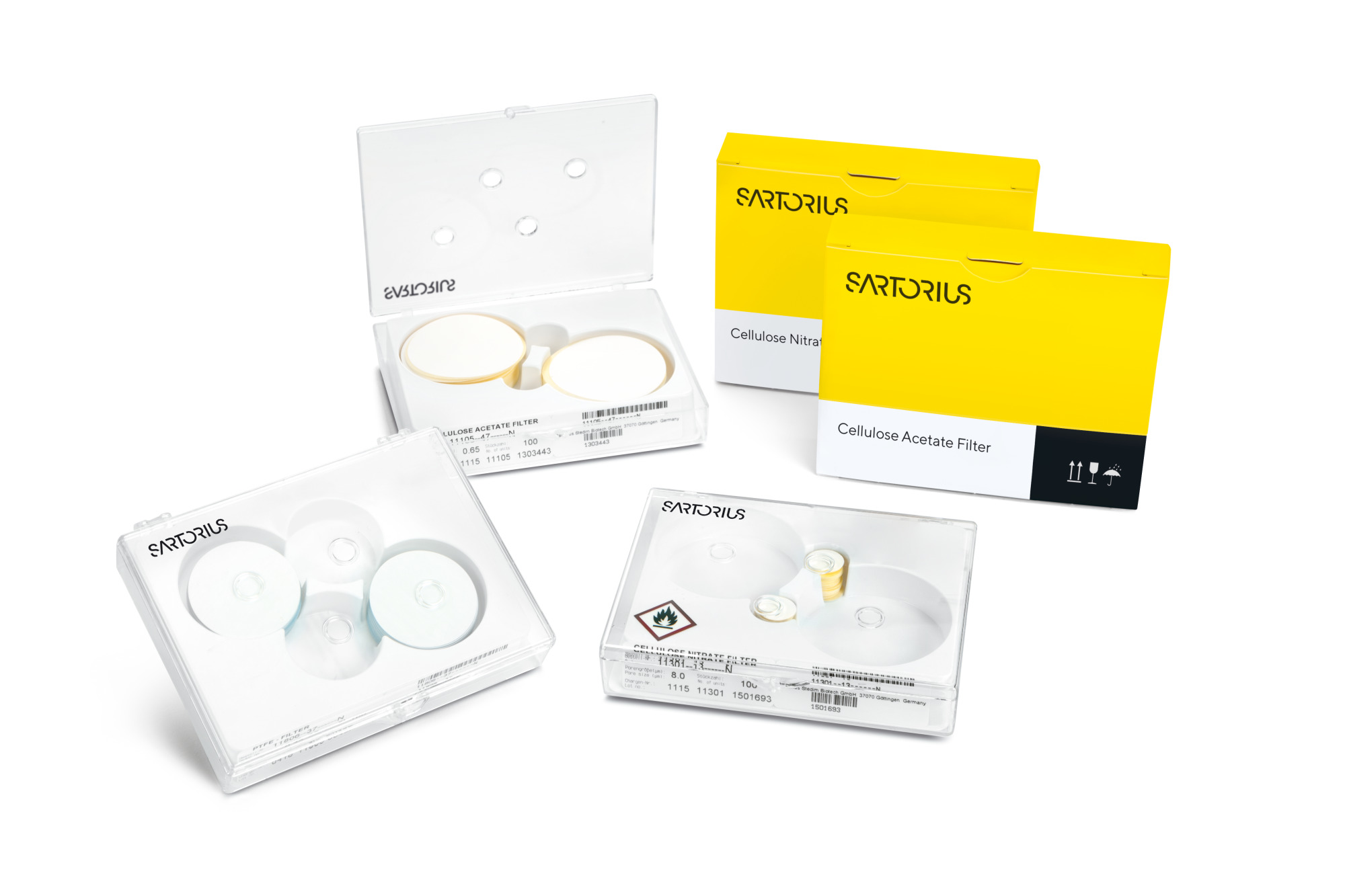
Filters | Membrane Filters
Sartorius membrane filters - membranes for almost all needs
- CN: Nitrocellulose - Blotting of protein or DNA
- CN (MCE): Cellulose Nitrate (Mixed Cellulose Ester) - Retention of particles and cells in aqueous solutions or air
- CA: Cellulose Acetate - Retention and removal of particles for aqueous solutions or air
- RC: Regenerated Cellulose - Removal of solvent or aqueous solution particles
- PES: Polyethersulfone - Filter aqueous media or solvents of pharmaceutical solutions and mixtures
- PA: Polyamide - Particle removal for solvents
- PTFE: Polytetra-fluoroethylene for solvents and gases - Particle removal
- PC-TEM: Polycarbonate Track-etched Membranes - Particle analysis in solvents, aqueous solutions or media
Cellulose nitrate (CN) membranes
Membrane filters made of cellulose nitrate or mixed cellulose esters are indicated for many general laboratory applications where a membrane with high nonspecific adsorption is suitable. They are hydrophilic, have a high flow rate due to their symmetrical structure and are compatible with aqueous solutions (pH 4 to 8), hydrocarbons and several other organic solvents. Cellulose nitrate membranes are available in different pore sizes from 0.2 μm to 8 μm.


Polyethersulfone (PES) membranes
Polyethersulfone (PES) membrane filters are hydrophilic, high flow rates and low nonspecific adsorbent membrane proteins. These properties make them excellent for filtering aqueous solutions as well as various solvents and pharmaceutical solutions. They are available in pore sizes from 0.1 μm to 0.45 μm and in multiple diameters. They are chemically resistant to a wide pH scale (1-14) and are sterilized by autoclaving.
Regenerated cellulose (RC) membrane filters
Regenerated cellulose membranes are very weak adsorption membranes that are also hydrophilic, solvent resistant (pH 3-12) and therefore suitable for removing particles from solvents. The membrane is asymmetrical and reinforced with non-woven cellulose which makes them very durable. They are available in two pore sizes: 0.45 μm and 0.2 μm and several diameters, which facilitates fine filtering for almost all needs. These membrane filters are solvent and pH resistant, have a fast flow and are available in the two sizes listed above.


Chemically resistant to alkaline solutions and organic solvents
Polyamide membrane (PA) filters
Polyamide membrane filters are hydrophilic and chemically resistant to alkaline solutions and organic solvents. They are recommended for the removal of particles from aqueous solutions and analytical determination solvents such as HPLC. They are also suitable for sterile filtration of these liquids, as well as for applications in which a membrane with relatively high nonspecific adsorption is acceptable. They are only available in two pore sizes (0.2 μm and 0.45 μm), but with multiple diameters.

Hydrophobic PTFE membranes
PTFE (polytetrafluoroethylene) membrane filters
PTFE (polytetra-fluoroethylene) membranes are permanently hydrophobic. These filters are used for filtration of filter air, gases or chemicals. Unlike other (hydrophilic) types of filters, they are not humidified by air humidity, which allows unobstructed air passage even at low differential pressures. PTFE membrane filters have excellent chemical compatibility (pH 1 to 14), so they are also used to filter solvents and acids, to which other types of filters are not resistant. Moreover, they can also be used for filtration of aqueous solutions, but due to their hydrophobic properties they must be pre-moistened with ethanol or methanol before filtering aqueous solutions of the medium.

Polycarbonate membrane filters (PC-TEM)
Peak in particle analysis
Polycarbonate membranes (PC-TEM) are uniquely structured and designed for specialized purposes in which their properties can be used. These white and hydrophilic polycarbonate membranes are made from high quality polycarbonate film using the latest technology. Membranes are excellent for accurate particle retention and analysis. The most common applications of these membranes include internal particle analysis, but also epifluorescence microscopy, fluid purification, cytology, cell biology, bioassays, water microbiology, and environmental analysis for their excellent optical characteristics.


